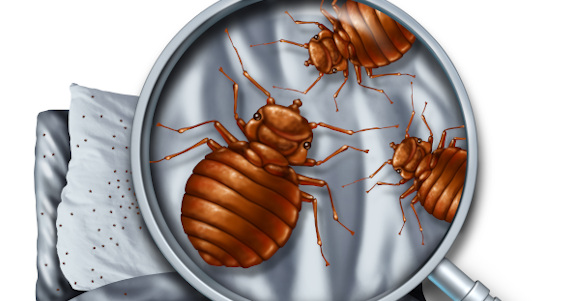
Should I Throw Out My Mattress If I Found Bed Bugs?
If you’ve found bed bugs on your mattress, you’re probably wondering if you should throw the mattress out. Bed bugs are a common fear among many, and like ticks, they survive on human blood. Not only are they unsightly, but they can be painful or itchy if you’ve been bitten. Bed bugs can cause major infestations in your home, apartment, or condo that can be difficult to get rid of. Here’s what you need to know about bed bugs and what to do if you have an infestation.
Signs of a Bed Bug Infestation
Bed bug infestations are incredibly common, and while they can be quite troublesome and inconvenient, they’re entirely treatable. Your home is not doomed forever. Bed bugs are very good “hitch-hikers”, and can invade your home in luggage, packed goods, etc. If you notice signs of an infestation, call a professional pest control service right away. If left untreated, the number of bugs will multiply quickly, making them even more challenging to get rid of. These insects are cryptic, very good at hiding, and are known to be tough, resistant and hardy. Because of this, many times the best treatment method of a home for bed bugs is fumigation. The fumigant will control the bed bugs, even in the hard to reach places. In an apartment or condo where fumigation may not be feasible, conventional liquid treatment to the room and adjacent rooms may be an option. Because treatment can be so burdensome, early detection and treatment at the first signs of activity is very important. It is very important to consult a professional pest control company when dealing with bed bugs, because these bugs are known for reinfesting. This is not an infestation a homeowner should try to treat on their own.
Signs of a Bedbug infestation: Small blood and fecal stains on your sheets and bedding
Bed bugs most often crawl onto sleeping humans or pets and feed on their blood until they become engorged. Once they’re full, they will crawl away to digest the meal. Unpleasant, yes. If you notice small red and brown spots of blood and fecal material on your bedding, and you know the blood is not from a cut or scrape you got the day before, there’s a possibility that you have bed bugs. You can find this staining in the areas you sleep, and also in the cracks and crevices on the perimeter of the bed mattress where bed bugs like to rest when they digest your blood.
Bites on your skin
Bed bugs bite, and you’ll know when they do. If you start noticing bites on your body that you can’t explain, especially right upon waking, it may be bed bugs. The bites may itch or swell and cause pain. They usually appear in lines because a bed bug will feed in a small area on your body, though not always. Some people may experience a blistering reaction or break out in hives. The bites appear in multiples and may be confused for a rash or allergic reaction. They are red and typically appear on areas of your skin that are exposed at night, as that’s when the bugs come out to feed.
Bed Bud Exoskeletons
Like ants, cockroaches, crabs, and crustaceans, bed bugs have an exoskeleton. An exoskeleton is the skeleton of the insect, but insects where them on the outside of their bodies, as a “skin”. Bed bugs shed their exoskeleton as they grow. Immature nymphs shed their skin and gradually develop and morph into adults. If you begin finding these small bed bug or insect shells around your bed, you may have bed bugs. The shells are translucent, with a brown tint.
What Do Bed Bugs Look Like and Where Do They Hide?
If you’ve been noticing signs of a bed bug infestation, you’ll want to know what the little pests look like and where they’re hiding. Routine and recurring pest control is important, as a certified applicator on site regularly can help you find and identify these insects and signs.
Appearance
Bed bugs are similar in size to an Appleseed. They can be a reddish-brown, light brown, or tan in color, and they are oval-shaped and flat. If they have recently fed, they become more rounded and red in color. Unfortunately, where there is one, there are always more.
Where Bed Bugs Hide
While the name seems self-explanatory, bed bugs can infiltrate more than just mattresses. They can inhabit clothing, sofas, dog beds, curtains, carpets, etc. They can also hide in the crevices of furniture like nightstands and dressers, and even behind wall hangings. If you’re on the hunt for bed bugs, you’ll want to check your mattress first, but remain aware of other places they may be.
To check your mattress for bed bugs, remove the sheets and bedding. Bed bugs often hide in the folds or the seams of the mattress. They can even make their way into the box spring or the area around your headboard. Additionally, you may find them along baseboards in your room, by the edges of the carpet.
How to Prevent Infestations
If you’ve ever had a bed bug problem, or are looking to prevent a possible infestation in the future, there are steps that you can take. First, if you know that a friend or family member currently has an infestation, stay away from the home until it’s been treated. Bed bugs can cling to your clothes and shoes, and you run the risk of tracking them into your own house.
Check furniture from garage sales and free furniture on the side of the road for signs of bed bugs before you purchase it or bring it home. If you see signs of a current or former infestation, stay away.
Use a mattress and pillow encasement. Mattress and pillow encasements are made from a material that’s designed to prevent bed bugs from making their way into your bedding. They can also serve as anti-allergens, protect against dust mites, and are often waterproof. They are low cost and can be purchased at most home goods stores or online.
Should I Throw Out My Mattress If I Found Bed Bugs?
Often, people panic and start throwing away bedding, clothing, pillows, and mattresses once they’ve found a bed bug infestation. However, this isn’t always necessary. A professional pest control service can effectively treat bed bug infestations, and just throwing out your mattress may not solve your problem. If you buy a new mattress but don’t kill the other bed bugs that are hiding in your room, they will just come back. It is very important to inspect the entire room or home and fumigate or treat wherever needed.
Why You Shouldn’t Just Throw Out Your Mattress If You Find Bed Bugs
The problem with tossing your mattress once you’ve found bug beds is that the insects reside in more than just your bed. Since they hide in carpets, and even behind picture frames and in nightstands, you aren’t eradicating the problem. In fact, you could be making it worse. As you drag your mattress through your house, you risk depositing the bugs and their eggs in areas of your home that they may not have reached yet, creating an even greater infestation. Throwing out your mattress, or any of your furniture, should not be the primary and only method of control. However, after an infestation has been eliminated, many homeowners opt to purchase a new mattress for peace of mind.
Why You Shouldn’t Try to Treat Bed Bugs On Your Own
Bed bugs are a tricky pest, and it can be almost impossible to eliminate the infestation without the help of a professional. This is because there are so many places the bugs can hide, and those places are often challenging to reach. Secondly, these bugs are extremely hardy and resilient. Because of this, sometimes structural tent fumigation is the only recommended treatment. Once your problem is solved, it is very important to have routine pest control. This way you can make sure that if bed bugs were to try and reinfest, early detection and treatment would prevent the infestation from getting out of control.
The best way to ensure that the infestation is completely gone is to contact a pest control company as soon as you notice the problem. If you require a home consultation regarding a bed bug problem, contact us at Hulett Environmental Services today to schedule your free inspection.



